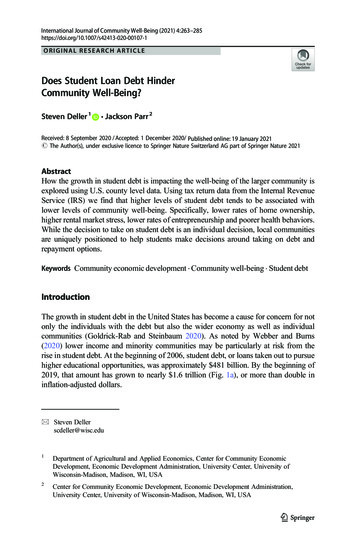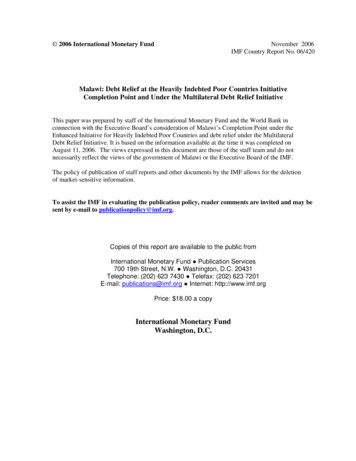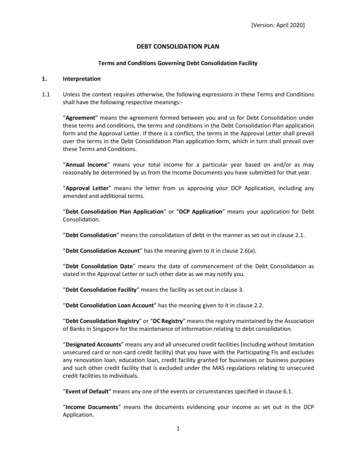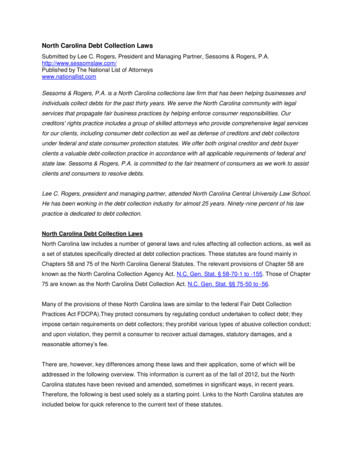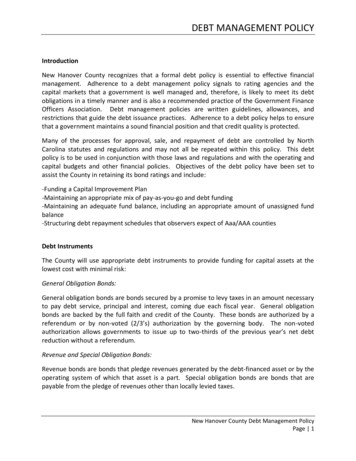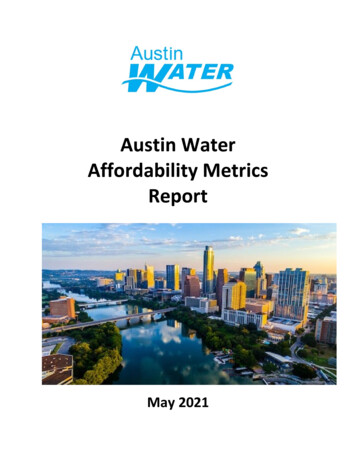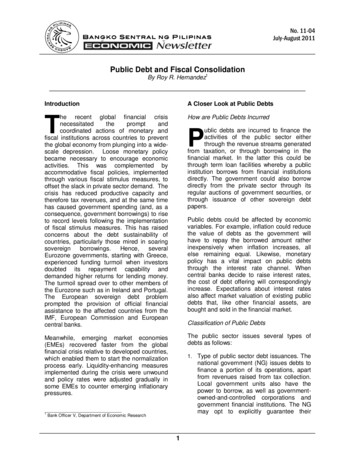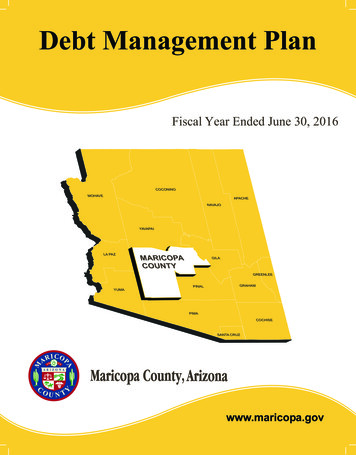
Transcription
Debt Management PlanFiscal Year Ended June 30, 2016COCONINOMOHAVEAPACHENAVAJOYAVAPAILA CHISESANTA CRUZ
Maricopa County, ArizonaDebt Management PlanTable of ContentsINTRODUCTION TO DEBT . 1Current Debt Situation . 1Debt Issuance History . 2Financing Alternatives . 2Pay-As-You-Go Financing . 3Grants . 3Short-Term Borrowing (Notes) . 3General Obligation Bonds (GO) . 4Revenue Bonds . 4Capital Leases (Lease-Purchase Obligations) . 4Certificates of Participation (COP) . 4Lease Trust Certificates . 4Installment Purchase Agreements . 5Special Assessment Bonds . 5Debt Limit . 5Debt Per Capita . 5Rating Agency Analysis . 6History of Debt Rating . 7Ratio Analysis . 8Debt Obligations by Type:General Obligation Bonds . 9Lease Revenue Bonds . 10Certificates of Participation . 10Stadium District . 11Capital Leases . 12Housing Authority of Maricopa County . 13Special Assessment Districts. 14iMaricopa County, ArizonaDepartment of Finance
Short-Term Borrowing . 15DEBT POLICIES . 16Administration of Policy . 16Use of Debt Financing . 16Method of Sale . 16Competitive Sale. 16Negotiated Sale. 16Use of Bond Insurance. 17Arbitrage Liability Management . 17Selection of Professional Services . 17Continuing Disclosure of County Financial Information. 18Maturity Structures . 18Ratings . 18Modification to Policies. 19INDIVIDUAL DEBT SERVICE SCHEDULES . 20iiMaricopa County, ArizonaDepartment of Finance
Debt Management PlanINTRODUCTION TO DEBTA comprehensive debt plan should be developed by all jurisdictions intending to issue debt. Thepurpose of Maricopa County’s Debt Management Plan is to set forth the parameters for issuingdebt, to manage the debt portfolio and provide guidance to decision makers regarding the timingand purposes for which debt may be issued.Provisions of the debt plan must be compatible with the County’s goals pertaining to the capitalprogram and budget, the financial plan, and the operating budget. A debt plan should attain anappropriate balance between establishing limits on the debt program and providing sufficientflexibility to enable the County to respond to unforeseen circumstances and new opportunitiesthat may benefit the County. This document is not intended to review the County’s total financialposition. It is a study of the County’s current debt position, as growth in the County could resultin an increased need for capital financing. Revenues, as well as needs, should drive the County’sdebt issuance program.Decisions regarding the use of debt will be based in part on the long-term needs of the Countyand the amount of equity (cash) dedicated in a given fiscal year to capital outlay. A disciplined,systematic approach to debt management should allow the County to enhance its credit ratings,while at the same time meeting the growing demands of the County’s capital projects.The information contained herein reflects the current debt status of Maricopa County for the fiscalyear ended June 30, 2016. The tables have been compiled by the Department of Finance.Portions of this Debt Management Plan are contained in the Comprehensive Annual FinancialReport (CAFR) for the fiscal year ended June 30, 2016. A copy of the CAFR can be obtained at:http://www.maricopa.gov/Archive.aspx?AMID 67Current Debt SituationIt is recognized that all debt, regardless of the source of revenue pledged for repayment,represents some sort of cost to taxpayers or ratepayers. Therefore, all types of Countydebt/obligations are considered herein. While lease-secured and certificates of participationobligations may not be debt under strict legal definitions, they still require future appropriationsand are a fixed charge. These lease payments and other non-bonded obligations are added bymost security analysts when calculating an issuer’s debt ratios.1Maricopa County, ArizonaDepartment of Finance
Debt Management PlanDebt Issuance HistoryThe County has used debt financing for many years to finance capital projects. The followingchart illustrates the amount of debt as well as categories of outstanding debt for the past five fiscalyears.LONG-TERM LIABILITIESAll Categories of DebtMaricopa County, ArizonaFor the year ending June 30Year Ending June 302012Governmental activities:Bonds, loans, and other payables:General obligation bondsLease revenue bondsCertificates of participationStadium District revenue bonds (1)Stadium District loans payable (1)Special assessment debt withgovernmental commitment (1)Capital leasesTotal Governmental activitiesBusiness-type activities: (1) (2)Capital leases, loans, and other payables:Capital LeasesLoans payableOther long-term debtTotal Business-type activities 130,815,00030,945,0006,906,8572013 120,350,00022,440,0005,706,8572014 108,975,00019,260,000-2015 97,135,000185,580,00016,010,000-2016 44,72722,9138,329,09117,981,211 168,746,907 148,561,536 128,284,465 307,098,818 271,024,124 2,787,9172,787,917 3,609,9431,300,2834,910,226 1,792,2803,667,473914,1786,373,931 1,792,2804,071,132569,1116,432,523 1,734,0603,989,532602,4046,325,996Notes:(1) Does not represent an obligation of the County.(2) Beginning in fiscal 2014, the Housing Authority presentation changed from a special revenue fund to a majorproprietary fund (enterprise fund). The fiscal year 2012 and 2013 long-term liability amounts were adjusted as a resultof the change in presentation and for corrections of prior periods.Financing AlternativesThe County should evaluate all potential funding sources before considering which method offinancing may be the most appropriate. There are many sources of funding, depending on the typeof debt to be incurred and the length of time for repayment. Sources of funding may include: currentrevenues and fund balances; intergovernmental grants from federal, state or other sources; staterevolving funds or loan pools; private sector contributions through impact fees or public/privatepartnerships; and debt financing.2Maricopa County, ArizonaDepartment of Finance
Debt Management PlanPay-As-You-Go FinancingThis method means that capital projects are paid for from the government’s current revenue base.The County does not issue bonds and does not have to repay the borrowings over time.There are several advantages to this method. For example, pay-as-you-go financing will save theamount of interest which otherwise would be paid on bonds issued to finance the program. Thegovernment is not encumbered by as much debt service when economic conditions deteriorate dueto normal business cycles. Since the use of current revenues can be adjusted in a given budgetyear, pay-as-you-go financing can provide greater budgetary flexibility than does a debt issue. Thejurisdiction’s long-term debt capacity is preserved for the future. Finally, lower debt ratios may havea positive effect upon the jurisdiction’s credit rating.Relying on current revenues to finance capital improvements also presents several disadvantages.Exclusive reliance upon pay-as-you-go funds for capital improvements means that existing residentsare obliged to pay for improvements that will benefit new residents who relocate to the area. If thejurisdiction is forced to finance the improvements within a single budget, the large capital outlayrequired for some projects may result in an onerous tax burden. The County must be careful toensure that the use of current revenues for capital projects does not diminish its availability torespond to emergencies and ongoing mandated services.GrantsGovernment grants stem from a variety of sources, but the majority of grant revenues for capitalprojects come from federal and state governments. Grants often require a County matchingcontribution. Most grants require an application from the County, identifying specific improvementsor equipment that will be purchased with the grant money.Short-Term Borrowing (Notes)Short-term financing is defined as debt maturing not later than one year after the date of its issuance.There are basically three reasons for using short-term debt: A vehicle to deal with temporary cash flow difficulties. This situation arises when cash receiptsdo not follow the same pattern as cash outlays.To handle unexpected costs resulting from natural emergencies or other significant unexpectedevents.In anticipation of issuing a long-term bond for capital financing. This form of financing offers anopportunity to borrow for short periods until the true, final costs of a project are known.Tax Anticipation Notes (TANs) are notes issued in anticipation of the collection of taxes, asreferenced in the Arizona Revised Statutes (A.R.S.), Title 35, Chapter 3, Article 3.1. They provideoperating funds to meet regular payroll and other operating expenses. During the fiscal year whentax payments are received, sufficient sums are used to retire the note. The timing of the note sale,the note’s due date, and repayment of funds are all components of cash flow and cash managementanalysis.Lines and Letters of Credit – Where their use is judged by the Chief Financial Officer to be prudentand advantageous to the County, the County has the power to enter into agreements withcommercial banks or other financial entities for purposes of acquiring lines or letters of credit. The3Maricopa County, ArizonaDepartment of Finance
Debt Management PlanBoard of Supervisors must approve any agreement with financial institutions for the acquisition oflines or letters of credit.General Obligation Bonds (GO)Bond security is the taxing power of the state or local government, as referenced in the A.R.S., Title35, Chapter 3, Article 3, for new GO bonds and Title 35, Chapter 3, Article 4 for refunding bonds. Anissuer selling a GO bond secured by its full faith and credit attaches to that issue its broadest pledge.This makes the security of these bonds very high. The full faith and credit backing of a GO bondincludes the pledge of all general revenues, unless specifically limited, as well as, the legal meansto raise tax rates to cover debt service. The public entity is authorized to levy property taxes or todraw from other unrestricted revenue streams such as sales or income taxes to pay the bond’sprincipal and interest. Interest rates on these bonds are generally the lowest of any public securitiesdue to this superior security. Prior to issuance, Arizona GO bonds must have a majority vote approvalfrom the residents of the County.Revenue BondsRevenue bonds are long-term debt instruments retired by specific dedicated revenues. Often theserevenues are generated by the project funded out of debt proceeds. Revenue bonds are designedto be self-supporting through user fees or other special revenues (i.e. excise taxes, rents or fees).The general taxing powers of the jurisdiction are not pledged. The debt created through the issuanceof revenue bonds is to be repaid by the earnings from the operations of a revenue producingenterprise, from special taxes, or from contract leases or rental agreements. County revenue bondsdo not burden the constitutional or statutory debt limitation placed on the County because they arenot backed by the full faith and credit of the issuer. The underlying security is the revenue streampledged to pay the bond principal and interest.Capital Leases (Lease-Purchase Obligations)This financing technique provides long-term financing through a lease (with a mandatory purchaseprovision). Lease-purchase agreements use non-appropriation clauses to avoid being classified aslong-term debt, which might be subject to State legal restrictions. This clause allows the governmentto terminate the lease without penalty. Security for lease-purchase financing is the lease paymentsmade by the County and, where legally permitted, also the asset being financed.Certificates of Participation (COP)Certificates of Participation represent proportionate interests in semiannual lease payments.Participation in the lease is sold in the capital markets. The County’s obligation to make leasepayments is subject to annual appropriations made by the County for that purpose. Rating agenciestypically give Certificate of Participation issues a grade below that of general obligation bonds.A.R.S., Title 11, Chapter 2, Article 4, §11-251, Paragraph 46, provides for a maximum repaymentterm of twenty five years for the purchase or improvement of real property.Lease Trust CertificatesLease Trust Certificates financing provides long-term financing through a lease (with a mandatorypurchase provision). This method does not constitute indebtedness under a state or localgovernment’s constitutional debt limit and does not require voter approval. The asset being financedcan include new capital asset needs or assets under existing lease agreements.4Maricopa County, ArizonaDepartment of Finance
Debt Management PlanInstallment Purchase AgreementsSame as a lease purchase agreement with the exception that the County takes title to the propertyup front.Special Assessment BondsSpecial Assessment Bonds are issued to districts (Special Assessment Districts) that are within alegally designated geographic area located within the County, which through consent of the affectedproperty owners pay for basic infrastructure and public improvements to the area throughsupplemental assessment. This financing approach achieves the objective of tying the repaymentof debt to those property owners who most directly benefit from the improvements financed. SpecialAssessment Districts are further described in A.R.S., Title 48, Chapter 6, Article 1.Debt LimitThe Arizona Constitution, Article 9, Section 8, states that a County indebtedness pertaining togeneral obligation bonds may not exceed six percent of the value of the County’s taxable propertyascertained by the last assessment. All general obligation bonds must be approved by votersregardless of amount issued up to the six percent limit. The County may issue non-general obligationbonds without voter approval up to six percent of the taxable property. However, with voter approval,the County may become indebted for an amount not to exceed fifteen percent of such taxableproperty.The following table represents the County’s outstanding general obligation indebtedness withrespect to its constitutional general obligation debt limitation.2015-16 Constitutional General Obligation Bonding CapacityMaricopa County, Arizona2015-16 Limited Property Value 15% of Limited Property ValueLess: GO Bonded Debt Outstanding34,623,670,3235,193,550,548-Plus: GO Debt Service Fund BalanceUnused Fifteen Percent Borrowing Capacity 5,193,550,548Debt Per CapitaDebt per capita measures the amount of debt outstanding per citizen in a government’s jurisdiction.Debt per capita is calculated by dividing total outstanding County debt by the County’s population.This calculation is used as a comparative benchmark to other counties. In addition, credit ratingagencies calculate debt per capita when evaluating a County’s ability to repay its debt obligations.5Maricopa County, ArizonaDepartment of Finance
Debt Management PlanThe following chart illustrates the five-year debt per capita for Maricopa County.Debt Per Capita - Maricopa County as of June 30, 2016Source: Office of the Arizona State Treasurer Report of Bonded IndebtednessRating Agency AnalysisIndependent assessments of the relative credit worthiness of municipal securities are provided byrating agencies. They furnish letter grades that convey their assessment of the ability and willingnessof a borrower to repay its debt in full and on time. Credit ratings issued by these agencies are a majorfunction in determining the cost of borrowed funds in the municipal bond market.Moody’s Investors Service, Standard & Poor’s Ratings Services (S&P), and Fitch Ratings are thethree major rating agencies that rate municipal debt. These rating agencies have provided a ratingassessment of credit worthiness for Maricopa County. There are seven primary factors that comprisetheir ratings: Institutional framework – legal and practical environment of local governmentEconomy – stability of trends in local income and total market value per capitaManagement – financial and operational decisions, policies and practices, leadershipBudgetary flexibility – available fund balance, ability to raise revenues or reduce expendituresBudgetary performance – current fiscal balance of general fund and total governmental fundsLiquidity – availability of cash and cash equivalentsDebt and contingent liabilities – debt ratios, debt policies, pension obligations, long-term planningEach of the rating agencies has their own method of assigning a rating on the ability and willingnessof a borrower to repay in full and on time. Issuers must pay a fee for the opportunity to have one ormore rating agencies rate existing and proposed debt issuance. The following chart outlines howthe ratings reflect creditworthiness, ranging from very strong securities to speculative and defaultsituations. Examples of the rating systems are:6Maricopa County, ArizonaDepartment of Finance
Debt Management PlanBOND RATINGSRATING AGENCIESExplanation of corporate/municipal bondratingsFitchMoody’sStandard &Poor’sPremium CCCCCaCCCCHigh qualityMedium qualityMedium grade, lower qualityPredominantly speculativeSpeculative, low gradePoor to defaultHighest speculationLowest quality, no interestIn default, in arrearsQuestionable valueCDDDDDDDDDDDDFitch and Standard & Poor’s may use “ ” or “-” to modify ratings while Moody’s may use numericalmodifiers such as 1 (highest), 2, or 3.History of Debt RatingIn February 2017, Fitch Ratings affirmed the County’s general obligation bond rating at 'AAA', thehighest level rating possible for general obligation bonds and affirmed the ‘AA ’ rating for theCounty’s Certificates of Participation, Series 2015. Citing the County’s strong operating performanceenabled by expenditure flexibility and strong growth prospects, Fitch Ratings views MaricopaCounty's rating outlook as stable. Fitch Ratings – February 2017In June 2015, Standard & Poor's Ratings Services (S&P) assigned its 'AA ' long-term rating toMaricopa County, Certificates of Participation, Series 2015. At the same time, S&P affirmed its 'AAA'issuer credit rating (ICR) on Maricopa County, the highest level rating possible for general obligationbonds and its 'AA ' long term rating on the County's existing lease revenue bonds. With its diverseeconomic base, strong management financial policies, budgetary flexibility, and low overall net debt,S&P views the County's long-term outlook as stable. S&P Ratings – June 2015In June 2015, Moody's Investors Service assigned its Aa1 rating to the Maricopa County, Certificatesof Participation, Series 2015. At the same time, Moody's has affirmed Maricopa's previously issuedlease revenue bonds Aa1 and also affirms the County's Aaa Issuer Rating. With its strong creditcharacteristics and well-managed financial operations, Moody’s views Maricopa County’s ratingoutlook as stable. Moody’s Investor Services – June 2015Additional information on Maricopa County's bond ratings can be viewed on the Maricopa Countywebpage: https://www.maricopa.gov/902/Bond-Rating.7Maricopa County, ArizonaDepartment of Finance
Debt Management PlanThe following illustrates a history of the County’s various debt ratings.Date RatingDate RatingStandard &Date RatingType of ral ObligationAAA (1)2/2/2017Aaa (1)6/1/2015AAA (1)6/3/2015C.O.P.AA (1)2/2/2017Aa16/1/2015AA 6/3/2015AA 6/1/2015Aa1 (1)6/1/2015AA (1)6/3/2015Lease Revenue(1) Bond rating is “Affirmed”Ratio AnalysisRating analysts compare direct net debt to the population in order to measure the size ormagnitude of the County’s debt. This ratio is referred to as the Direct Net Debt Per Capita Ratio.The same ratio is applied to all debt within the County which includes School Districts, Cities andTowns, and Special Districts. This ratio is referred to as the Overall Net Debt Per Capita Ratio.The taxable value of the County is a measure of the County’s wealth. It also reflects the capacityof the County’s ability to service current and future debt. The ratio of Direct Net Debt as apercentage of Full Value (FV) Property is the comparison of direct net debt to the County's taxablevalue. The same ratio is applied to all debt within the County and is referred to as the Overall NetDebt as a percentage of Full Value Property. The Full Value Property Per Capita ratio representsthe per capita value of taxable property in the County. An explanation of how each ratio iscalculated is included in the notes adjacent to the following tables.There are an infinite number of ratios, which could be calculated to measure the County’s debtburden. The following analysis focuses on commonly used ratios instead of creating customizedones. The ratios calculated are for governmental activities. The source of repayment is from eitherthe secondary tax levy or by appropriation from the general fund for debt service payments. Debtfor which there is a source of repayment, i.e. pledged revenues for car rental service charge, debtservice has been excluded.8Maricopa County, ArizonaDepartment of Finance
Debt Management PlanDIRECT AND OVERALL NET DEBTMARICOPA COUNTY, ARIZONAAuditedGOVERNMENTAL ACTIVITESLease Revenue BondsCertificate of ParticipationCapital leasesDirect Net DebtOverlapping Debt (1)Overall Net Debt 8,329,09117,981,211291,044,091 258,316,2117,804,652,1727,899,891,537 8,095,696,263 8,158,207,748 Ratios (4)Direct Net Debt Per CapitaOverall Net Debt Per Capita 4,076,438339,536,633 711,986Projected6/30/20166/30/201754,755,000 51,095,000185,580,000185,580,000 Population Estimate (2)Full Value of Taxable Property (3)Direct Net Debt as % of FV PropertyOverall Net Debt as % of FV PropertyFV Property Per 76403,013,955Projected ,215,830 143,769,0717,935,015,6738,013,401,012 8,180,231,503 8,157,170,083 4,233,286443,207,235 4,315,627475,077,340 62 1,972 581,932 331,8900.086%2.384%83,292 0.064%2.024%97,415 0.055%1.846%104,696 0.030%1.717%110,083Notes:(1) Projected overlapping debt for 2017 and 2018 was based on a three year average of general obligation bonds for Cities,Towns, School Districts and Special Assessment Districts.Source: http://www.aztreasury.gov/bid-reports/(2) Projections for 2017 and 2018 population are based on estimates provided by the Arizona Department of Administration.Source: https://population.az.gov/(3) Full Cash Value Taxable Property was provided by Maricopa County Assessor’s Office (in thousands of dollars).(4) Summary of Debt Ratios: Direct Net Debt per capita Direct Net Debt/Population Overall Net Debt per capita Overall Net Debt/Population Direct Net Debt as a percentage of Full Value (FV) Property Direct Net Debt/FV Property Overall Net Debt as a percentage of FV Property Overall Net Debt/FV Property FV property per capita FV Property/PopulationDebt Obligations by TypeGeneral Obligation BondsLong-term general obligation bonds shall be issued to finance significant capital improvementsfor purposes set forth by voters in bond elections. Interest rates on these bonds are generally thelowest of any public securities. Prior to issuance, Arizona general obligation bonds must have amajority vote approval from the residents of the County.On July 1, 2004, the County made the final debt service payment on the outstanding generalobligation bonds, which were the result of the 1986 general election where the voters authorizedthe County to issue long-term debt. The resulting proceeds from the sale of the bonds were usedfor the purpose of making improvements in the County which included Criminal and Civil CourtsFacilities, Juvenile Court and Juvenile Treatment and Detention Facilities, Law Enforcement andPublic Safety, Regional Park Improvements, Environmental Protection, Sanitary Landfill, PublicHealth Facilities, Infrastructure, Communication Improvements, etc.9Maricopa County, ArizonaDepartment of Finance
Debt Management PlanLease Revenue BondsOn May 23, 2007, the Maricopa County Public Finance Corporation issued 108,100,000 ofLease Revenue Bonds, Series 2007A, to pay for the acquisition, construction, and renovation ofthe Durango Animal Care and Control Facility and various court facilities. Under the terms of thebond indentures, the Corporation received the proceeds to construct and purchase these assetsand the County will make lease payments to extinguish the debt. Lease payments will equal theaggregate amount of principal and interest due at that date. Upon the final lease payment, thetitle to the assets will transfer to the County. The County’s obligation to make lease payments willbe subject to and dependent upon annual appropriations being made by the County. Bondsmaturing on and after July 1, 2017, are subject to optional redemption in increments of 5,000 onJuly 1, 2016, or any date thereafter, at par plus accrued interest to the date fixed for redemption.In the event of nonappropriation, the bonds would be subject to special redemption at par plusaccrued interest to the redemption date.On June 22, 2016, the Maricopa County Public Finance Corporation extinguished a portion of theLease Revenue Bonds, 2007A, in the amount of 29,910,000. The County placed the cash in anirrevocable trust to refund the bonds which were called for redemption on July 22, 2016.The following illustrates the outstanding Maricopa County Lease Revenue Bonds.DEBT SERVICE REQUIREMENTS TO MATURITYLease Revenue BondsMaricopa County, Arizona as of June 30, 2016Year Ending June 30201720182019202020212022-262027-28Total ,00025,405,0009,155,00054,755,000 2185,250,427368,08016,774,653 Total Debt 1830,655,4279,523,08071,529,653Certificates of ParticipationOn June 25, 2015, Maricopa County issued 185,580,000 of Certificates of Participation to payfor the acquisition of capital equipment and various capital projects. Some of the larger projectsinclude: Public Radio System, Technology In
Debt Management Plan. Maricopa County, Arizona Department of Finance i Maricopa County, Arizona Debt Management Plan Table of Contents . INTRODUCTION TO DEBT A comprehensive debt plan should be developed by all jurisdictions intending to issue debt. The
